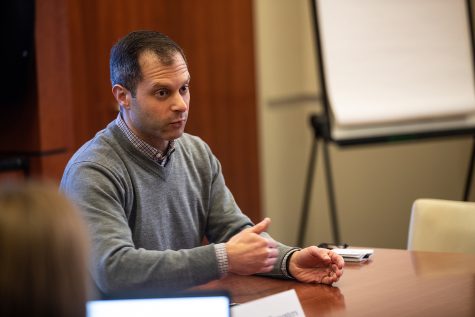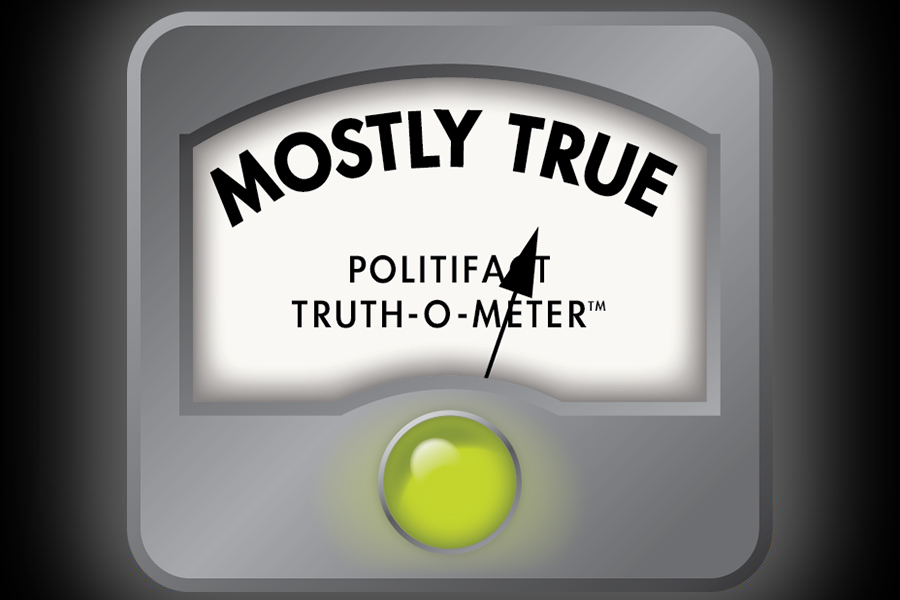Fact Check | Did Ohio maintain state funding for OSU after a public/private partnership similar to UI’s?
UI Faculty Council members feared at a Jan. 28 meeting that the utilities public/private partnership would result in less state funding for the UI. External Relations VP Peter Matthes said Ohio State University did not lose state funding for its energy deal.
February 27, 2020
PolitiFact Iowa is a project of The Daily Iowan’s Ethics & Politics Initiative and PolitiFact to help you find the truth in politics.
Edited by Lyle Muller and Marissa Payne
The state Board of Regents approved a University of Iowa $1.1 billion public/private partnership to maintain and operate its utility system for power, heat, chilled water and water treatment in December 2019. The move was controversial because the UI was giving control over one of its assets to a private firm. Moreover, university administrators and faculty members have expressed concerns about whether the university will receive less funding from the state for its general-operating budget in years to come.
The UI was responding to an August 2018 letter from Republican Gov. Kim Reynolds to Iowa’s regent universities asking the institutions to be more creative when thinking of new funding alternatives, UI President Bruce Harreld said in a December 2019 interview with The Daily Iowan. The UI started considering a public/private partnership in September 2018 to fill a funding gap for the university’s 2016-21 strategic plan, Harreld said.

University of Iowa English Professor Loren Glass speaks during a Faculty Council meeting on Tuesday, January 28, 2020. Glass asked whether OSU had been defunded for pursuing a public/private partnership.
At a UI Faculty Council meeting on Jan. 28, UI Vice President of External Relations Peter Matthes, senior adviser to the president, was asked by a faculty member if Ohio State University, which entered a public/private partnership for its energy system in 2017, was defunded by the state of Ohio as a result.
The UI looked at OSU’s agreement as a model for its partnership. Democratic lawmakers, Republican lawmakers and university faculty and staff have voiced concerns that the proceeds placed into a newly created partnership endowment in the agreement will incentivize the Iowa General Assembly to reduce state appropriations to the UI because of a possible perception that the university will now have a hefty revenue source to tap into.
ENGIE and Paris-based investment firm Meridiam partnered with the UI and gave the university an upfront lump-sum payment of $1.165 billion. After paying outstanding utility system bond debt and consultant fees, the UI will place the net proceeds of around $999 million into an endowment fund to grow over the course of the 50-year deal.
“Nope. Nope. And so, it is upon us to continue to educate legislators about the importance of this — this is not a replacement of state-appropriation dollars,” Matthes said during the faculty meeting. “This is in order for us to invest into the future for our students, for our families, and for Iowans into our strategic plan. That’s the reason why we did this.”
We found Matthes’ statement to be Mostly True in that OSU has received a consistent amount of funding via appropriations from its state Legislature, but with a bit of a twist. Before OSU entered into its energy public/private partnership July 2017, the beginning of the 2018 budget year, the university’s share of state appropriations increased from $361,961,488 in fiscal 2016 to $384,695,029 in fiscal 2017. But, by fiscal 2019, OSU’s funding had decreased to $383,610,170, after the state appropriations for higher education were frozen for two years.
The Ohio General Assembly budgeted conservatively from fiscal 2017 to fiscal 2019 to keep the Department of Higher Education funding at a flat rate instead of providing an increase, but funding was not cut during this period, Jeff Robinson, department director of communications, wrote in an email to PolitiFact.
For fiscal 2020, the Ohio Department of Higher Education plans call for the university to receive an increase to $392,764,233.

Vice President for External Relations Peter Matthes speaks during a Faculty Council meeting on Tuesday, January 28, 2020.
The Ohio Department of Higher Education, which runs that state’s public universities, allocates funding it receives from the Ohio Legislature. It uses a performance-based system called the State Share of Instruction to award funding, based on course and degree completion and student retention, Robinson wrote.
OSU entered its 50-year public/private partnership and lease for energy in April 2017, partnering with energy conglomerate ENGIE North America and independent investment firm Axium Infrastructure, creating Ohio State Energy Partners. The $1.165 billion agreement gave the university a $1.015 billion upfront payment, plus an additional $150 million in direct academic collaboration support, that was put in an endowment.
Harreld had said last fall the UI’s arrangement is a partnership that would not be a lease or sale but the agreement with University of Iowa Energy Collaborative LLC, an entity of ENGIE North America, is a long-term lease and concession agreement.
In an email to PolitiFact, OSU Director of Media Relations Benjamin Johnson wrote that the university also entered a public/private partnership in 2012 with its parking operations that generated $483 million that the university has invested in endowments to support academic initiatives.
The UI plans to allocate around $15 million annually from its partnership proceeds over 50 years through a grant process to fund proposals that support the campus strategic plan.
Our ruling
Matthes said a public/private energy agreement like the UI’s did not cause OSU to lose “state appropriation dollars.”
OSU’s funding increased by more than $20 million from fiscal 2016 — the budget year before its public/private partnership started — to fiscal 2017 when the deal was approved, but decreased by around $1 million from fiscal 2018 to fiscal 2019 after a two-year freeze on higher education appropriations. Funding is on track to increase in fiscal 2020, but no indication exists that it will continue to increase in future years. The statement is accurate but needs additional information, so we rate it Mostly True.
Sources
University of Iowa Faculty Council meeting, Iowa City, Iowa, Jan. 28, 2019
Email from Ohio State University Director of Media Relations Benjamin Johnson
Email from Ohio Department of Higher Education Director of Communications Jeff Robinson
Long-Term Lease and Concession Agreement for the University of Iowa Utility System
The Daily Iowan, UI faculty discuss early stages of public/private partnership allocations, Jan. 28, 2019
The Daily Iowan, Iowa Democratic lawmakers question risks of UI’s potential public/private partnership, Dec. 8, 2019
The Daily Iowan, Iowa lawmakers question UI president on utility system public/private partnership, Feb. 5, 2020
The Daily Iowan, Regents sign $1.1 billion UI Utility System public/private partnership, Dec. 10, 2019
The Daily Iowan, Harreld talks state funding, public/private partnership at State of the University speech, Oct. 10, 2019.
The Daily Iowan, Q&A: UI President Bruce Harreld talks public/private partnership, climate crisis, sustainability goals, Dec. 15, 2019
Letter from Iowa Gov. Kim Reynolds to the regent universities, Aug. 17, 2018
Ohio Department of Higher Education operating budgets, fiscal 2016 through fiscal 2020
Ohio State University, Energy Management

















